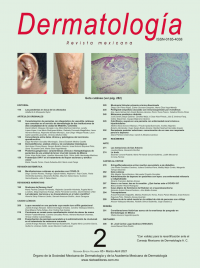Dermatofibroma: clinical analysis and histological varieties.
Dermatol Rev Mex. 2021; 65 (2): 138-148. https://doi.org/10.24245/dermatolrevmex.v65i2.5588
Itzel Anayn Flores-Reyes,1 Genaro Briseño-Gascón,2 Israel Antonio Esquivel-Pinto,3 Sonia Toussaint-Caire,4 María Elisa Vega-Memije4
1 Residente de Dermatología, Instituto Dermatológico de Jalisco Dr. José Barba Rubio, Jalisco, México.
2 Residente de Dermatología.
3 Dermapatólogo.
4 Dermatóloga y dermatopatóloga adscrita.
División de Dermatología, Departamento de Dermatopatología, Hospital General Dr. Manuel Gea González, Ciudad de México.
Resumen
ANTECEDENTES: El dermatofibroma es un tumor fibrohistiocítico con etiopatogenia controvertida, pues se duda si se trata de un proceso reactivo o neoplásico.
OBJETIVOS: Identificar y describir las características clínicas y variantes histológicas de los dermatofibromas provenientes del Hospital Dr. Manuel Gea González de la Ciudad de México y una clínica privada.
MATERIALES Y MÉTODOS: Estudio descriptivo de muestras histológicas e historias clínicas, provenientes de la División de Dermatología del Departamento de Dermatopatología del Hospital General Dr. Manuel Gea González y del laboratorio de Dermatopatología de una práctica privada de uno de los autores, de agosto de 1996 a junio de 2016.
RESULTADOS: Se incluyeron 602 muestras histológicas. La edad media de los pacientes fue de 41.3 ± 13.69 años. El sexo más afectado fue el femenino en el 73% (n = 440), con afectación en las extremidades inferiores en el 48.5% (n = 292). La variedad histológica más reportada fue la fibrocolagenosa (n = 522, 86.7%).
CONCLUSIONES: El dermatofibroma es un tumor fibrohistiocítico que afecta mayormente a mujeres de la tercera y quinta décadas de la vida en las extremidades inferiores. Se identificaron nueve variables histológicas: fibrocolagenosa o clásica, celular, hemosiderótica, atrófica, profunda, xantomatosa, traumatizada, mixoide y hemangioma-esclerosante; la variante histológica más frecuente fue la fibrocolagenosa.
PALABRAS CLAVE: Dermatofibroma; tumor fibrohistiocítico.
Abstract
BACKGROUND: Dermatofibroma is a fibrohistiocytic tumor with a controversial etiopathogenesis, since it is questionable whether it is a reactive or neoplastic process.
OBJECTIVES: To identify and describe the clinical and histopathological variants of dermatofibromas, coming from the General Hospital Dr. Manuel Gea González, Mexico City, and private practice.
MATERIALS AND METHODS: Descriptive study of histological samples and medical records from the Dermatology Division, Department of Dermatopathology of the General Hospital Dr. Manuel Gea González and a private practice Dermatopathology laboratory of one of the authors (in Mexico City), from August 1996 to June 2016.
RESULTS: Six hundred and two histological samples were included. The mean age of the patients was 41.3 ± 13.69 years. The most affected sex was female in 73% (n = 440), with topography in the lower extremities in 48.5% (n = 292). The evolution time was varied. The most reported histological variety was the fibrocollagenous 86.7% (n = 522).
CONCLUSIONS: Dermatofibroma is a fibrohistiocytic tumor that mainly affects women of the third and fifth decades, in the lower extremities. Nine histological variables were identified: 3 frequent (fibrocollagenous or classic, cellular and hemosiderotic), 4 infrequent (atrophic, deep, xanthomatous and traumatized), a histological curiosity (myxoid) and a combined variety (hemangioma-sclerosing); the most frequent variant was fibrocollagenous.
KEYWORDS: Dermatofibroma; Fibrohistiocytic tumor.
Recibido: septiembre 2020
Aceptado: octubre 2020
Este artículo debe citarse como: Flores-Reyes IA, Briseño-Gascón G, Esquivel-Pinto IA, Toussaint-Caire S, Vega-Memije ME. Dermatofibroma: análisis clínico y de variedades histológicas. Dermatol Rev Mex. 2021; 65 (2): 138-148

